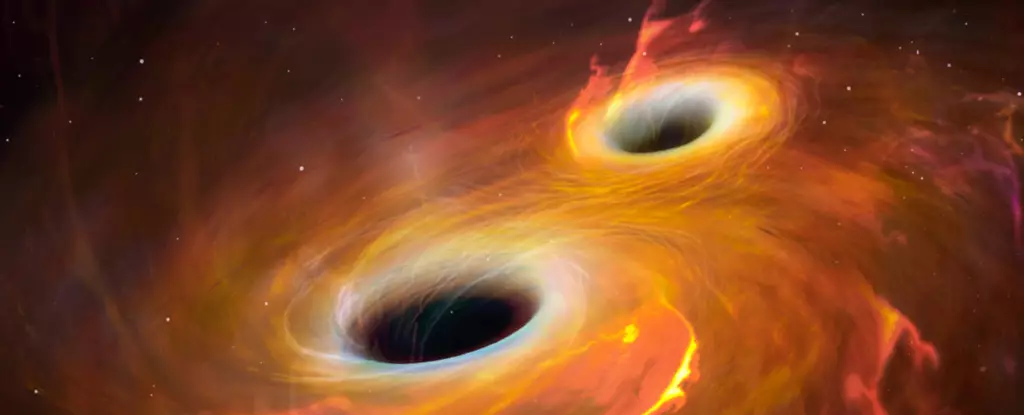At the heart of our Milky Way galaxy lies a dynamic and tumultuous region, marred by the presence of a supermassive black hole known as Sagittarius A* (Sgr A*). This cosmic epicenter is more than just a monstrous void; it serves as a bustling nexus where young stars are born, gas and dust congregate, and stellar remnants—like black holes—linger in shadows. The complexity of this environment is further heightened by an enigmatic shroud of interstellar gas and dust that obscures our view in visible light. While we can garner insights into the celestial ballet occurring around Sgr A* through infrared and radio emissions, much remains elusive, particularly regarding the number of stellar-mass black holes that populate this stellar neighborhood.
The Stellar Enigma: Quantifying Black Holes
Understanding the number of stellar-mass black holes in our galaxy’s center poses a significant challenge for astronomers. Traditional models paint a picture suggesting a relatively modest population, estimating around 300 black holes in proximity to Sgr A*. On the other hand, some theories propose that the formation of Sgr A* itself might have catalyzed the creation of numerous stellar-mass black holes. Towing a line between these differing perspectives, a groundbreaking study published in *Astronomy & Astrophysics* has emerged, proposing a far more extravagant hypothesis—one that posits a staggering abundance of stellar-mass black holes lurking near the galactic nucleus.
The Star Grinder: A New Paradigm of Stellar Evolution
The authors of this innovative study introduce an intriguing concept dubbed the “star grinder.” This model elucidates how the central region’s dense accumulation of gas and dust facilitates the rapid formation of large O-type and B-type stars, which, despite their short life spans, have monumental impacts on their surroundings. As these massive stars exhaust their nuclear fuel and end their lives in cataclysmic supernovae, their cores collapse into black holes. Concurrently, the ejected material enriches the interstellar medium, spawning new generations of stars.
Over extended periods, these cycles of star birth and death lead to a staggering accumulation of black holes within the restricted confines surrounding Sgr A*. The theory postulates that the density of black holes could potentially reach millions or even billions per cubic parsec, creating a harrowing environment for any star venturing into this zone. Here, stellar encounters with black holes could become commonplace, fostering an atmosphere of cosmic chaos where even the mightiest stars risk being torn apart.
Collision Time: Proving the Star Grinder Model
But as captivating as the star grinder model may be, the question arises: how can scientists empirically validate such a radical assertion? The researchers focus their inquiry through a statistical lens known as collision time, which predicts the average interval before a star collides with a black hole, contingent upon black hole density and star size. A larger number of black holes necessarily results in a shorter collision time. Conversely, the size of a star also plays a vital role in these interactions, with larger stars facing heightened risks.
Delving into computations, the research team varied black hole distributions and juxtaposed these models against their observations of the stellar population in the vicinity of Sgr A*. A key takeaway from their analysis indicates a lower prevalence of large O-type stars in the region compared to broader sections of the Milky Way. This notable scarcity is indicative of a “grinding” process whereby these significant stellar entities encounter black holes with regularity, ultimately leading them to end their evolutionary journey prematurely. This contrasts dramatically with the relative abundance of B-type stars, which seem to escape significant interaction with black holes.
Hypervelocity Stars: Evidence of a Chaotic Core
An intriguing consequence of the star grinder hypothesis emerges through the phenomenon of hypervelocity stars—celestial objects flinging themselves through our galaxy with extraordinarily high velocities to the extent that they may soon escape its gravitational embrace. With a handful of these stellar wanderers documented, theorists have pondered how such incredible speeds could be attained. The star grinder model provides a plausible explanation: close encounters with black holes could impart the necessary momentum to propel these stars into hypervelocity trajectories.
The existence of these elusive hypervelocity stars could, therefore, substantiate the notion that an opulent concentration of stellar-mass black holes is permeating the region surrounding Sgr A*. As the cosmos relentlessly evolves, exploring these intricate dynamics may not only give us insight into our galactic core but also transform our understanding of black hole formation and stellar evolution at large. The implications are expansive: if the star grinder model holds true, the realm of black holes in our galaxy could be more complex and fascinating than we have ever realized.

